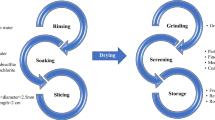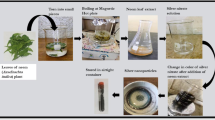Abstract
In the present work, the stability of grape marc powder was evaluated during its storage at room conditions for 6 months. Grape juice marc from Vitis labrusca cv. “Isabel” was dried to 8.8 ± 0.9 % moisture content (wet basis) in forced convection drying equipment at 70 °C, crushed and stored aseptically in dark polyethylene bags and kept at 25 ± 2 °C for up to 6 months. Grape marc powder was microbiologically safe, free of Salmonella sp., Bacillus cereus, and fecal coliforms. Total phenolic compounds with 1,1-diphenyl-2-pic-ryl-hydrazyl (DPPH) scavenging capacity and ferric reducing antioxidant power (FRAP) were stable, although monomeric anthocyanins and compounds with the capability of scavenging 2,2′-azino-bis(3-ethylbenzothiazoline-6-sulphonic acid) (ABTS) radicals showed to be susceptible to degradation through the storage period. Moisture sorption isotherm at 25 °C for the powder material was determined by static gravimetric methodology. The sorption isotherm of the grape marc powder showed a sigmoidal shape (type II), typical of food materials. The experimental data was satisfactorily fitted by the GAB (Guggenheim–Anderson–de Boer) model, giving a monolayer moisture content (X m) of 6.75 % (dry basis). Results indicate that grape marc powder can be considered as a potential functional ingredient with an acceptable stability.




Similar content being viewed by others
References
Al-Muhtaseb, A. H., McMinn, W. A. M., & Magee, T. R. A. (2002). Moisture sorption isotherm characteristics of food products: a review. Food and Bioproducts Processing, 80, 118–128.
American Public Health Association. (2001). Compendium of methods for the microbiological examination of foods (4th ed.). Washington DC: APHA.
AOAC official methods of analysis. (16th ed.) (1995) Washington: Association of Official Analytical Chemists.
Bezerra, C. V., Amante, E. R., Oliveira, D. C., Rodrigues, A. M. C., & Silva, L. H. M. (2013). Green banana (Musa cavendishii) flour obtained in spouted bed — effect of drying on physic-chemical, functional and morphological characteristics of the starch. Industrial Crops and Products, 41, 241–249.
Brand-Williams, W., Cuvelier, M. E., & Berset, C. (1995). Use of free radical method to evaluate antioxidant activity. LWT- Food Science and Technology, 28, 25–30.
Cassini, A. S., Marczak, L. D. F., & Noreña, C. P. Z. (2006). Water adsorption isotherms of texturized soy protein. Journal Food Engineering, 77, 194–199.
Chism, G. W., & Haard, N. F. (1996). Characteristics of edible plant tissues. In O. R. Fennema (Ed.), Food chemistry (pp. 943–1011). New York: Marcel Dekker.
Cladera-Olivera, F., Marczak, L. D. F., Noreña, C. P. Z., & Pettermann, A. C. (2009). Modeling water adsorption isotherms of pinhao (Araucaria angustifolia seeds) flour and thermodynamic analysis of the adsorption process. Journal of Food Process Engineering, 34(3), 826–843.
Coda, R., Lanera, A., Trani, A., Gobbetti, M., & Di Cagno, R. (2012). Yogurt-like beverages made of a mixture of cereal, soy and grape must: microbiology, texture, nutritional and sensorial properties. International Journal of Food Microbiology, 155, 120–127.
Cui, J., Juhasz, B., Tosaki, A., Maulik, N., & Das, D. K. (2002). Cardioprotection with grapes. Journal of Cardiovascular Pharmacology, 40, 762–769.
de Ancos, B., Ibañez, E., Reglero, G., & Cano, M. P. (2000). Frozen storage effects on anthocyanins and volatile compounds of raspberry fruit. Journal of Agricultural and Food Chemistry, 48, 873–879.
Demrow, H. S., Slane, P. R., & Folts, J. D. (1995). Administration of wine and grape juice inhibits in vivo platelet activity and thrombosis in stenosed canine coronary arteries. Circulation, 91, 1182–1188.
Doporto, M. C., Dini, C., Mugridge, A., Viña, S. Z., & García, M. A. (2012). Physicochemical, thermal and sorption properties of nutritionally differentiated flour and starches. Journal of Food Engineering, 113, 569–576.
Jay, J. M., Loessner, M. J., & Golden, D. A. (2005). Modern food microbiology (7th ed.). New York: Springer.
Kaymak-Ertekin, F., & Gedik, A. (2004). Sorption isotherms and isosteric heat of sorption for grapes, apricots, apples and potatoes. LWT- Food Science and Technology, 37, 429–438.
Keevil, J. G., Osman, H. E., Reed, J. D., & Folts, J. D. (2000). Grape juice, but not orange juice or grapefruit juice, inhibits human platelet aggregation. Journal of Nutrition, 130, 53–56.
Labuza, T. P. (1984). Moisture sorption: practical aspects of isotherm measurement and use. St. Paul, MN: American Association of Cereal Chemists.
Lee, J., Durst, R. W., & Wrolstad, R. E. (2005). Determination of total monomeric anthocyanin pigment content of fruit juices, beverages, natural colorants, and wines by the pH differential method: collaborative study. Journal of AOAC International, 88, 1269–1278.
Maier, T., Schieber, A., Kammerer, D. R., & Carle, R. (2009). Residues of grape (Vitis vinifera L.) seed oil production as a valuable source of phenolic antioxidants. Food Chemistry, 112, 551–559.
Margalit, Y. (1997). Oak products (Cooperage and cork). In Crum, J. (Ed.), Concepts in Wine Chemistry (pp. 236–252). San Francisco, CA: The Wine Appreciation Guild.
Mildner-Szkudlarz, S., Zawirska-Wojtasiak, R., Szwengiel, A., & Pacynski, M. (2011). Use of grape by-product as source of dietary fibre and phenolic compounds in sourdough mixed rye bread. International Journal of Food Science & Technology, 46, 1485–1493.
Özvural, E. B., & Vural, H. (2011). Grape seed flour is a viable ingredient to improve the nutritional profile and reduce lipid oxidation of frankfurters. Meat Science, 88, 179–183.
Park, K. J., Vohnikova, Z., & Brod, F. P. R. (2002). Evaluation of drying parameters and desorption isotherms of garden mint leaves (Mentha crispa L.). Journal of Food Engineering, 51, 193–199.
Peng, X., Ma, J., Cheng, K. W., Jiang, Y., Chen, F., & Wang, M. (2010). The effects of grape seed extract fortification on the antioxidant activity and quality attributes of bread. Food Chemistry, 119, 49–53.
Pownall, T. L., Udenigwe, C. C., & Aluko, R. E. (2010). Amino acid composition and antioxidant properties of pea seed (Pisum sativum L.) enzymatic protein hydrolysate fractions. Journal of Agricultural and Food Chemistry, 58, 4712–4718.
Re, R., Pellegrini, N., Proteggente, N., Panala, A., Yang, M., & Rice-Evans, C. (1999). Antioxidant activity applying an improved ABTS radical cation decolorization assay. Free Radicals Biology and Medicine, 26, 1231–1237.
Sahari, M. A., Boostani, F. M., & Hamidi, E. Z. (2004). Effect of low temperature on the ascorbic acid content and quality characteristics of frozen strawberry. Food Chemistry, 86, 357–363.
Sahin, S., & Sumnu, S. G. (2006). Water activity and sorption properties of foods. In S. Sahin & S. G. Sumnu (Eds.), Physical properties of foods (pp. 193–226). New York: Springer Science + Business Media.
Sakihama, Y., Cohen, M., Grace, S., & Yamasaki, H. (2002). Plant phenolic antioxidant and prooxidant activities: phenolics-induced oxidative damage mediated by metals in plants. Toxicology, 177, 67–80.
Sant’Anna, V., Brandelli, A., Marczak, L. D. F., & Tessaro, I. C. (2012a). Kinetic modeling of total polyphenol extraction from grape marc and characterization of the extracts. Separation and Purification Technology, 100, 82–87.
Sant’Anna, V., Marczak, L. D. F., & Tessaro, I. C. (2012b). Kinetic modeling of anthocyanin extraction from grape marc. Food and Bioprocess Technology. doi:10.1007/s11947-012-1016-1.
Saura-Calixto, F. (2011). Dietary fiber as a carrier of dietary antioxidants: an essential physiological function. Journal of Agricultural and Food Chemistry, 59, 43–49.
Singleton, V. L., & Rossi, J. A. (1965). Colorimetry of total phenolics with phosphomolybdic–phosphotungstic acid reagents. American Journal of Enology and Viticulture, 16(3), 144–158.
Spada, J. C., Noreña, C. P. Z., Marczak, L. D. F., & Tessaro, I. C. (2013). Water adsorption isotherms of microcapsules with hydrolyzed pinhão (Araucaria angustifolia seeds) starch as wall material. Journal of Food Engineering, 114, 64–69.
Stein, J. H., Keevil, J. G., Wiebe, D. A., Aeschlimann, S., & Folts, J. D. (1999). Purple grape juice improves endothelial function and reduces the susceptibility of LDL cholesterol to oxidation in patients with coronary artery disease. Circulation, 100, 1050–1055.
Toit, M., Engelbrecht, L., Lerm, E., & Krieger-Weber, S. (2011). Lactobacillus: the next generation of malolactic fermentation starter cultures – an overview. Food and Bioprocess Technology, 4, 876–906.
Torres, C., Díaz-Maroto, M. C., Hermosín-Gutiérrez, I., & Pérez-Coello, M. S. (2010). Effect of freeze-drying and oven-drying on volatiles and phenolics composition of grape skin. Analytica Chimica Acta, 600, 177–182.
Vashisht, T., Singh, R. K., & Pegg, R. B. (2011). Effects of drying on the phenolics content and antioxidant activity of muscadine pomace. LWT- Food Science and Technology, 44, 1649–1657.
Vega-Gálvez, A., Ah-Hen, K., Chacana, M., Vergara, J., Martínez-Monzó, J., García-Segovia, P., Lemus-Mondaca, R., & Di Scala, K. (2012). Effect of temperature and air velocity on drying kinetics, antioxidant capacity, total phenolic content, colour, texture and microstructure of apple (var. Granny Smith) slices. Food Chemistry, 132, 51–59.
Young, J. F. (1967). Humidity control in the laboratory using salt solutions: a review. Journal of Applied Chemistry, 17, 241–245.
Yousif, A. N., Durance, T. D., Scaman, C. H., & Girard, B. (2000). Headspace volatiles and physical characteristics of vacuum-microwave, air, and freeze-dried oregano (Lippia berlandieri Schauer). Journal of Food Science, 65, 926–930.
Zhang, L., Li, J., & Zhou, K. (2010). Chelating and radical scavenging activities of soy protein hydrolysates prepared from microbial proteases and their effect on meat lipid peroxidation. Bioresource Technology, 101, 2084–2089.
Zhu, K., Zhou, H., & Qian, H. (2006). Antioxidant and free radical-scavenging activities of wheat germ protein hydrolysates (WGPH) prepared with alcalase. Process Biochemistry, 41, 1296–1302.
Acknowledgments
Authors thank the financial support from Conselho Nacional de Desenvolvimento Científico e Tecnológico (CNPq) and Coordenação de Aperfeiçoamento Pessoal de Nível Superior (MEC-CAPES-PNPD), Brazil.
Author information
Authors and Affiliations
Corresponding author
Rights and permissions
About this article
Cite this article
Sant’Anna, V., Englert, A.H., Corrêa, A.P.F. et al. Grape Marc Powder: Physicochemical and Microbiological Stability During Storage and Moisture Sorption Isotherm. Food Bioprocess Technol 7, 2500–2506 (2014). https://doi.org/10.1007/s11947-013-1198-1
Received:
Accepted:
Published:
Issue Date:
DOI: https://doi.org/10.1007/s11947-013-1198-1




